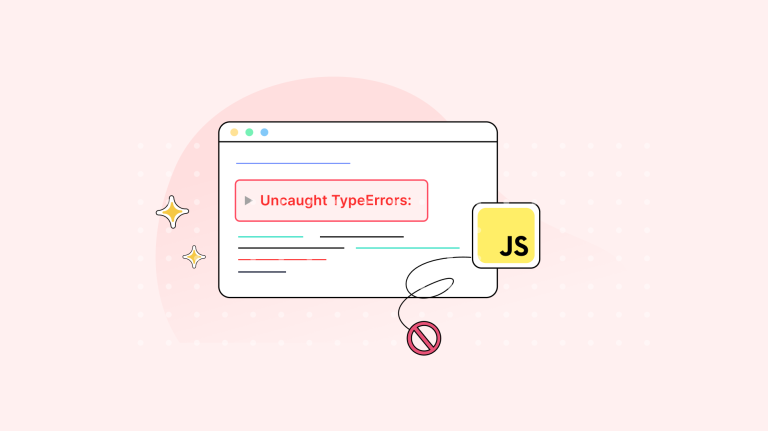There can be frustration, even some anxiety, around seeing error messages when you’re learning a new language or updated syntax. If you’re not familiar with the structure of an error message, and the optimal way to parse it, your learning process often slows down. So, let’s have a refresh (maybe it’s an introduction for you) on error patterns, to help get past this stage in your journey.
For developers, understanding error messages is a vital skill. Because that understanding leads to faster and easier responses to these messages. And once you understand how error messages work, you can avoid repeating them – nobody on your team will ask “did you Google the error message?” again.
Read on to find out more about how to parse one specific error that JavaScript throws: the Uncaught TypeError. At Tiny, while we’re continuously improving the TinyMCE rich text editor, we’re also working on new guides to better support our community. Here, you’ll find a quick guide on understanding and responding to the Uncaught TypeErrors JavaScript error.
What are Uncaught TypeErrors?
Uncaught TypeErrors are thrown as a response to different JavaScript syntax problems where the type of data isn’t correctly configured. More broadly speaking, they’re caused by:
- Attempts to modify a value that cannot be modified or changed
- Using a value in a way that does not make sense to JavaScript's set of types
- More specifically when a function expects only one type of data, but receives an altogether different kind of data from an argument or operand passing on data
Solving Uncaught TypeErrors involves carefully checking your JavaScript to see if there are attempts to modify values that cannot change, and investigating the types of data sent and received.
Uncaught TypeErrors and JavaScript data types
Since the type of data is an important part of understanding these errors, understanding exactly what data types JavaScript uses, can add to your understanding of Uncaught TypeErrors.
The data types available in JavaScript
There are a set of data types available that are immutable, and are called primitive data types:
- String: Usually takes the form of text in quotation marks.
- Number: A number, no quotation marks.
- Bigint: A very large number that’s too large for the Number data type.
- Boolean: True or False values.
- Symbol: Broadly speaking, a unique identifier created using the symbol() method. They really are unique – it’s one point that sets the Symbol data type apart from others.
- Null: Refers to an absence of value that JavaScript regards as an Object with no discernable value, represented by the “NULL” value.
- Undefined: A variable without any value. In contrast with Null, Undefined is a data type without any value, and “NULL” is still a value.
Then there is the Object data type. This data type is a collection of properties, and can be arrays, for example, and are usually recognized by their key and value pair structure.
Understanding Uncaught TypeErrors
To better understand Uncaught TypeErrors, the first step is to acknowledge that errors contain useful information for software development. The messages returned by errors (usually) contain all the information you need to classify and respond to them. Take a moment to recognize the error message pattern in JavaScript:
- The name or type of the error appears first
- This is followed by the location; line number and file name
When checked in the browser developer console, error message patterns also show a stacktrace, showing how one error cascades through the different functions and variables set in your JavaScript file. It's vital information to see what parts of your project are affected by the error. The stack trace can become lengthy in production, with multiple JavaScript files, so it's important to have a solid grasp of understanding errors so you can parse a stack trace rapidly and not feel swamped by information.
Applying data types to Uncaught TypeErrors
To understand Uncaught TypeErrors, start by looking at how the error is related to the set of data types available in JavaScript. One common cause of the Uncaught TypeError is when a function is set up, but is then passed a data type that it's not designed for. The Odin Project learning resource on errors provides a clear example:
- The push() function is meant to add items to arrays
- When it's asked to handle a string, a completely different data type compared to an array, it returns the Uncaught TypeError
- The "not a function" message refers to the fact that push() is not a function designed for the string data type
By thinking carefully about what data type you’re working with (Is it a string? Or an array?) as well as parsing the error message, you may find the solution to the Uncaught Type Error more quickly, and then be able to respond.
Uncaught TypeError best practice
Best practice when handling Uncaught TypeErrors is to make use of the console.log() statement in your JavaScript. This is useful for outputting the information contained in constants and variables to see exactly what the data type is by its appearance in the browser developer console.
✏️NOTE: Other useful methods to test out are console.table() for outputting data in a table format, and console.trace(), which will outputs a clear stack trace to the console.
More learning resources and developer insights
At Tiny, we’re always working on creating useful resources to better support our community. There’s more learning resources available on software development, and with useful developer insights:
- Agile, Waterful, or Hybrid development: choosing the right practice for your team
- Modular Programming explained, beyond the spaghetti mess
- Software Development trends identified through Stack Overflow survey analysis
Contact us for more information on what TinyMCE can add to your project.
